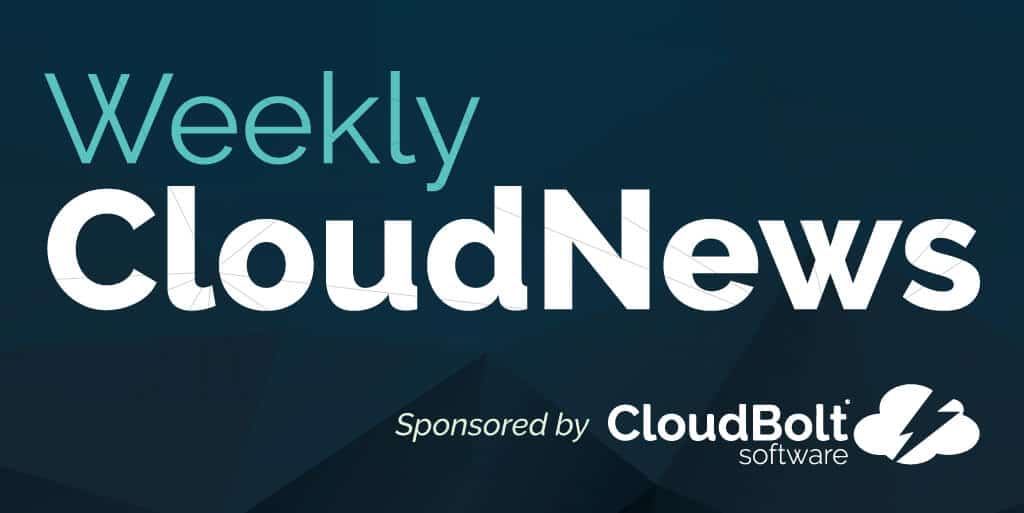Weekly CloudNews: Is Repatriation the Answer to Rising Cloud Costs?

Welcome to this week’s edition of CloudBolt’s Weekly CloudNews!
Here are the blogs we’ve posted this week:
- Why You Need to Empower Your Developers with Self-Service IT Today – Webinar Recap
- Why Azure Reservations are Key to Azure Cost Optimization
With that, onto this week’s news:
As cloud costs climb, is repatriation the answer?
Jen A. Miller, CIO Dive, July 12, 2021
“Dropbox saved nearly $75 million by repatriating workloads from the public cloud and building its own tech infrastructure, the company detailed in its S-1. That such a large company would move largely off public cloud, where startups often begin and established companies shed legacy systems to get to, seemed an anomaly.
But as cloud computing continues to mature, the costs of running such infrastructure is catching up creating a “trillion dollar paradox,” according to a recent report from venture capital firm Andreessen Horowitz (a16z), coauthored by Sarah Wang, a partner at a16z, and Martin Casado, general partner at a16z. In analysis of cloud spend at 50 of the top public software companies — including Adobe, DocuSign, Slack and Zoom — a16z estimates cloud infrastructure costs and impact on margins are eating away at $100 billion in market value.”
Google’s new cloud computing tool helps you pick the greenest data centers
Daphne Leprince-Ringuet, ZDNet, July 13, 2021
“In another bid to make cloud computing eco-friendlier, Google has created a new tool to push customers who are picking their next cloud region towards choosing infrastructure that is more sustainable. When users browse through their options to manage cloud resources, Google will flag regions that have the lowest carbon impact highlighted with a leaf symbol and a “Lowest CO2” label. The new feature is already appearing as part of the location selector inside Cloud Console, which lets Google’s customers manage the different elements that power cloud applications, ranging from bills to databases through cloud regions.
To earn a green badge of honor, a given cloud region will need to achieve a Carbon Free Energy Percentage (CFE%) of at least 75%, which means that on average, renewable energy is used three-quarters of the time to power the data centers in the area. Where information about the CFE% is not available, the region will instead have to show a low grid carbon intensity, which corresponds to the average emissions generated by the local grid when it is necessary to use fossil fuel energy. This can vary greatly from one region to the other, and has a direct impact on the sustainability of data centers in the area. Earlier this year, the advertising-to-cloud giant released a dataset containing the hourly CFE% and grid carbon intensity for the majority of its regions, to reflect the average mix of carbon-free and fossil-fuel energy that is used to power its data centers in different cloud regions.”
Report: Most essential US businesses are cloud-ready
Esther Shein, TechRepublic, July 12, 2021
“Some 94% of mid-sized essential businesses in the United States are adopting cloud this year, up from 25% that declared cloud a strategic priority in 2020, a new report finds. Further, 75% of mid-sized businesses expect to be fully recovered from the impact of COVID-19 by 2022, while 61% expect to expand in size and scale over the coming three years, according to Epicor Software’s annual insights report.
A key takeaway from this year’s study ‘is the sea change in attitude toward cloud as a critical business accelerant. Leaders have moved from consideration to adoption,’’ said Steve Murphy, CEO of Epicor, during his keynote address at the annual customer Insights conference. ‘While the companies who make, move and sell what is most essential to economic growth may be all aboard the cloud train, the data suggests their implementation needs vary vastly,’ Murphy said. ‘This is no longer a ‘why move’ conversation but rather a ‘how to move’ to gain advantage.’”
We’re here to help you anywhere on your hybrid and multi-cloud journey. Request a demo today.
Related Blogs

The Future of Cloud Cost Management and Optimization is Here with CloudBolt
It’s an exciting time to be in the Cloud Cost Management and Optimization space. The landscape is quickly changing as…

